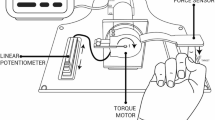Abstract
We have exposed human participants to both full-movement and pulsatile viscous force perturbations to study the effect of force duration on the incremental transformation of sensation into adaptation. Traditional views of movement biomechanics could suggest that pulsatile forces would largely be attenuated as stiffness and viscosity act as a natural low-pass filter. Sensory transduction, however, tends to react to changes in stimuli and therefore could underlie heightened sensitivity to briefer, pulsatile forces. Here, participants adapted within perturbation duration conditions in a manner proportionate to sensed force and positional errors. Across perturbation conditions, we found participants had greater adaptive sensitivity when experiencing pulsatile forces rather than full-movement forces. In a follow-up experiment, we employed error-clamped, force channel trials to determine changes in predictive force generation. We found that while participants learned to closely compensate for the amplitude and breadth of full-movement forces, they exhibited a persistent mismatch in amplitude and breadth between adapted motor output and experienced pulsatile forces. This mismatch could generate higher salience of error signals that contribute to heightened sensitivity to pulsatile forces.






Similar content being viewed by others
References
Brashers-Krug T, Shadmehr R, Bizzi E (1996) Consolidation in human motor memory. Nature 382:252–255
Chen WJ, Poppele RE (1978) Small-signal analysis of response of mammalian muscle spindles with fusimotor stimulation and a comparison with large-signal responses. J Neurophysiol 41:15–27
Cheng S, Sabes PN (2007) The trial-to-trial dynamics of visually guided reaching reveal continual changes driven by error corrective feedback and internal drift. J Neurophysiol 97:3057–3069
Conditt MA, Gandolfo F, Mussa-Ivaldi FA (1997) The motor system does not learn the dynamics of the arm by rote memorization of past experience. J Neurophysiol 78:554–560
DeAngelis GC, Ohzawa I, Freeman RD (1995) Receptive-field dynamics in the central visual pathways. Trends Neurosci 18:451–458
Donchin O, Francis JT, Shadmehr R (2003) Quantifying generaliztaion from trial-by-trial behavior of adaptive systems that learn with basis functions: theory and experiments in human motor control. J Neurosci 23:9043–9045
Efron B, Tibshirani RJ (1998) An introduction to the bootstrap. Chapman and Hall/CRC, Boca Raton
Fine MS, Thoroughman KA (2006) Motor adaptation to single force pulses: sensitive to direction but insensitive to within-movement pulse placement and magnitude. J Neurophysiol 96:710–720
Fine MS, Thoroughman KA (2007) Trial-by-trial transformation of error into sensorimotor adaptation changes with environmental dynamics. J Neurophysiol 98:1392–1404
Goodbody SJ, Wolpert DM (1998) Temporal and amplitude generalization in motor learning. J Neurophysiol 79:1825–1838
Hwang EJ, Smith MA, Shadmehr R (2006) Adaptation and generalization in acceleration-dependent force fields. Exp Brain Res 169:496–506
Itti L, Baldi P (2009) Bayesian surprise attracts human attention. Vision Res 49:1295–1306
Kawato M, Furukawa K, Suzuki R (1987) A hierarchical neural-network model for control and learning of voluntary movement. Biol Cybern 57:169–185
Lackner JR, Dizio P (1994) Rapid adaptation to Coriolis force perturbations of arm trajectory. J Neurophysiol 72:299–313
Oldfield RC (1971) The assessment and analysis of handedness: the Edinburgh inventory. Neuropsychologia 9:97–113
Poggio T, Bizzi E (2004) Generalization in vision and motor control. Nature 431:768–774
Pouget A, Snyder LH (2000) Computational approaches to sensorimotor transformations. Nat Neurosci 3(Suppl):1192–1198
Rumelhart DE, Hinton GE, Williams RJ (1986) Learning internal representations by error propagation. In: Rumelhart DE, McClelland JL (eds) Parallel distributed processing: explorations in the microstructure of cognition, vol 1. MIT Press, Cambridge
Scheidt RA, Reinkensmeyer DJ, Conditt MA, Rymer WZ, Mussa-Ivaldi FA (2000) Persistence of motor adaptation during constrained multi-joint, arm movements. J Neurophysiol 84:853–862
Scheidt RA, Dingwell JB, Mussa-Ivaldi FA (2001) Learning to move amid uncertainty. J Neurophysiol 86:981–985
Shadmehr RA, Mussa-Ivaldi FA (1994) Adaptive representation of dynamics during learning of a motor task. J Neurosci 14:3208–3224
Sing GC, Joiner WM, Nanayakkara T, Brayanov JB, Smith MA (2009) Primitives for motor adaptation reflect correlated neural tuning to position and velocity. Neuron 64:575–589
Smith MA, Ghazizadeh A, Shadmehr R (2006) Interacting adaptive processes with different timescales underlie short-term motor learning. PLoS Biol 4:1035–1043
Taylor JA, Thoroughman KA (2007) Divided attention impairs human motor adaptation but not feedback control. J Neurophysiol 98:317–326
Thoroughman KA, Shadmehr R (2000) Learning of action through adaptive combination of motor primitives. Nature 407:742–747
Thoroughman KA, Taylor JA (2005) Rapid reshaping of human motor generalization. J Neurosci 25:8948–8953
van der Helm FCT, Rozendaal LA (2000) Musculoskeletal systems with intrinsic and proprioceptive feedback. In: Winters JM, Crago PE (eds) Biomechanics and neural control of posture and movement, 1st edn. Springer-Verlag New York, Inc., New York, pp 192–203
Wagner MJ, Smith MA (2008) Shared internal models for feedforward and feedback control. J Neurosci 28:10663–10673
Wei K, Kording KP (2009) Relevance of error: what drives motor adaptation? J Neurophysiol 101:655–664
Widrow B, Hoff ME (1960) Adaptive switching circuits. Conference proceedings of WESCON, pp 96–104
Winters JM (2000) Terminology and foundations of movement science. In: Winters JM, Crago PE (eds) Biomechanics and neural control of posture and movement, 1st edn. Springer-Verlag New York, Inc., New York, pp 3–35
Acknowledgments
We thank D. N. Tomov for technical management and M. A. Smith for providing technical comments on implementation of the force channel. This work was supported by the U.S. National Institutes of Health Grants R01 HD-055851 and R01 NS-057813. P. A. Wanda was also supported by the U.S. National Science Foundation IGERT 0548890 through the Cognitive, Computational, Systems Neuroscience Pathway at Washington University in St. Louis.
Conflict of interest
The authors have declared that no competing interests exist.
Author information
Authors and Affiliations
Corresponding author
Electronic supplementary material
Below is the link to the electronic supplementary material.
Rights and permissions
About this article
Cite this article
Wanda, P.A., Fine, M.S., Weeks, H.M. et al. Brevity of haptic force perturbations induces heightened adaptive sensitivity. Exp Brain Res 226, 407–420 (2013). https://doi.org/10.1007/s00221-013-3450-3
Received:
Accepted:
Published:
Issue Date:
DOI: https://doi.org/10.1007/s00221-013-3450-3




